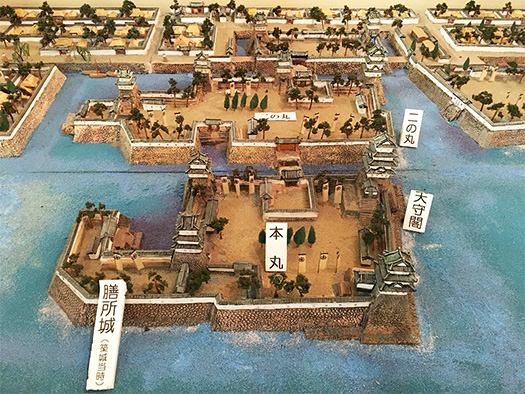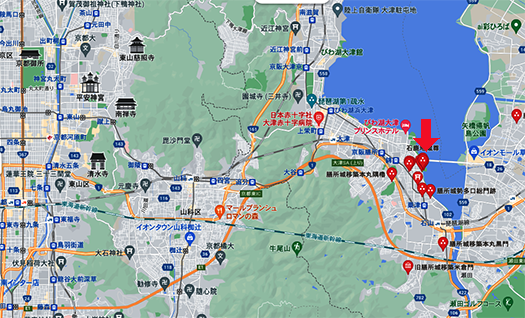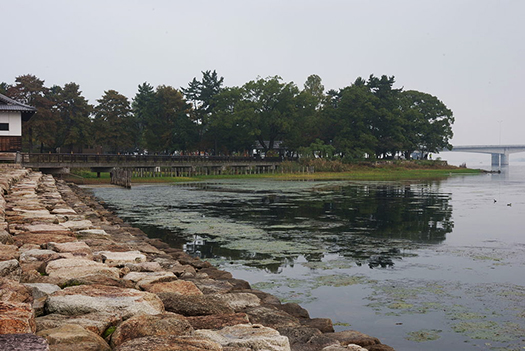


関ヶ原で勝利した後に家康は藤堂高虎に命じて「膳所城」を築城した。
この膳所城は古来「瀬田を制するものは天下を制する」と言われる地。
東国から京都に向かう琵琶湖南端に位置していて、
源平合戦期でも木曽義仲軍がここでの戦闘で平家に勝利し、
その義仲は関東の範頼・義経軍にここを突破されて敗死した。
京都自体は北以外は開かれた地理にあって特段の防衛山岳を持たない。
都市計画の発想において風水的着眼、律令国家的な都市設計だった。
関ヶ原の勝利以降、当然自らの天下構想に基づいて家康は
この瀬田一帯をどのようにコントロール下に置くべきか、
さまざまに構想を巡らせたに違いない。
その上で築城の名人とされた藤堂高虎を外様ながら重用して設計施工に当たらせた。
地図でわかるように膳所城は今日の「近江大橋」直近の位置であり、
琵琶湖の水運にとっても、そして東海道「国道1号線」にとってもまさに要衝地。
現代では東海道新幹線、高速道路E1号線、そして国道1号などの幹線が通る。
この古今を通しての東西交通の最重要地域を掌握する城として構想された。
その設計施工に当たっての家康と藤堂高虎の打合せの様子を
既述の安部龍太郎「下天を謀る」では想像力豊かに活写している。
この城郭は琵琶湖最南端に対して「水城」としてせり出して建築された。
水運に対しても陸上交通に対してもそれを制御し、支配することが可能な配置。
水域に対して基礎工事を行っていく技術的困難を琵琶湖周辺の有力建築団、
「穴太衆」と綿密に打合せながら工事を成功させていったとされる。
おおむね蓋然性の高い描写ではなかったかと思われた。
水流を統御しながら木杭を湖面に打ち込んで行ってとっかかりを作り、
そこに礎石を大量に投入して足場を固めて行く工事段取り。
工事の結果、水上を制圧する本格的な「水城」がみごとに出来上がった。
家康の天下支配に当たって対上方の軍事政治上の拠点として有用な城郭。
ここでの水城成功体験から、その後支配地「今治城」築城でも
瀬戸内海水運を支配することに藤堂高虎は成功している。
家康の戦略においてきわめて重要な京都・西国の交通要衝地を押さえられた。
こういう水城での人工的島嶼土木建築技術を確立させたことがあきらか。
家康の腰巾着のウザいヤツ、という藤堂高虎の評価は逆に、
かれの果たした役割の大きさを物語っているのだろう。
家康の周到な全国支配戦略に於いてそれが破綻せず、
江戸時代250年以上の国内平和を実現させた意味に於いて有益だった。
この水城築城成功の一件は、藤堂高虎自身にとっても、
また戦国末期、江戸期の穴太衆など「大手ゼネコン」による工事ラッシュにとっても
非常に重要なメルクマールになったのではないのだろうか?
English version⬇
The development of strategic eyes and construction techniques for the key strategic point “Zensho Castle” Nara and Wakayama Exploration-27].
Whoever controls Seta controls the whole country. The construction of a water castle by creating artificial ground in Seta, the most important strategic point for the realization of peace in the Edo period, is a strategy for regional defense. Nara and Wakayama
After his victory at Sekigahara, Ieyasu ordered Takatora Todo to build “Zessho Castle.
This Zesho Castle is the place where it has been said since ancient times, “He who controls Seta controls the whole country.
It was located at the southern tip of Lake Biwa on the way to Kyoto from the eastern part of the country.
During the Genpei War, Kiso Yoshinaka’s army defeated the Heike clan in a battle here.
Yoshinaka was defeated by Noriyori and Yoshitsune’s forces from Kanto, who broke through here.
Kyoto itself is an open geography except to the north and has no special defensive mountains.
The city was designed from a feng shui perspective and in the manner of the Ritsuryo State in urban planning.
After his victory in Sekigahara, Ieyasu naturally decided
How should this area of Seta be under his control?
Ieyasu must have been thinking about how he should control the Seta area.
He then had Takatora Todo, who was regarded as a master of castle construction, design and construct the castle even though he was a foreigner.
As you can see on the map, Zesho Castle is located near today’s Omi Ohashi Bridge.
It was a strategic point for the water transportation of Lake Biwa and for the Tokaido Highway Route 1.
Today, the Tokaido Shinkansen bullet train, the E1 expressway, and National Route 1 all pass through the area.
The castle was conceived as a castle that would control the most important area for east-west transportation throughout the ages.
Ieyasu and Takatora Todo had a meeting about the design and construction of the castle.
Ryutaro Abe’s “Geden wo kakiru” (Conspiring for the future), already mentioned, vividly and imaginatively describes the discussions between Ieyasu and Takatora Todo in designing and constructing the castle.
This castle was built to overhang the southernmost point of Lake Biwa as a “water castle.
The castle was built to control and dominate both water and land transportation.
The technical difficulty of constructing the foundation against the water was solved by working closely with the Anata-shu, an influential group of builders around Lake Biwa.
It is said that they succeeded in the construction while closely discussing the technical difficulties of building a foundation against the water with the “Anata-shu,” a group of influential builders around Lake Biwa.
This is a highly plausible description.
The wooden piles were driven into the surface of the lake while controlling the water flow to create a starting point, and a large number of foundation stones were placed there.
The construction setup involved driving wooden piles into the surface of the lake while controlling the water flow to create a foothold, and then placing a large number of foundation stones to solidify the foothold.
As a result of the construction, a full-scale “water castle” was successfully built to control the water.
This castle was useful as a military and political base for Ieyasu’s rule in the upper part of Japan.
The success of this castle led to the construction of Imabari Castle, which was later used as a castle in the area of Ieyasu’s control.
Takatora Todo succeeded in controlling the Seto Inland Sea water transportation.
He was able to seize a strategic point for transportation between Kyoto and the western part of Japan, which was extremely important in Ieyasu’s strategy.
It is clear that he established artificial island civil engineering and construction techniques in these water castles.
The reputation of Takatora Todo as an annoying lackey of Ieyasu is on the contrary.
Ieyasu’s pawns.
Ieyasu’s strategy of carefully controlling the whole country did not break down, and he was able to maintain domestic peace for more than 250 years during the Edo period.
Ieyasu’s strategy to control the whole country did not break down, and it was beneficial in terms of achieving domestic peace for more than 250 years during the Edo period.
The success of the construction of Suijo Castle was also a great success for Takatora Todo himself.
and for the rush of construction by “major general contractors” such as Anotashu in the late Sengoku and Edo periods.
This success may have been a very important merkmal for Takatora Todo himself and for the rush of construction by “major general contractors” such as Anata-shu in the late Sengoku and Edo periods.
Posted on 5月 15th, 2022 by 三木 奎吾
Filed under: 住宅マーケティング, 歴史探訪







コメントを投稿
「※誹謗中傷や、悪意のある書き込み、営利目的などのコメントを防ぐために、投稿された全てのコメントは一時的に保留されますのでご了承ください。」
You must be logged in to post a comment.